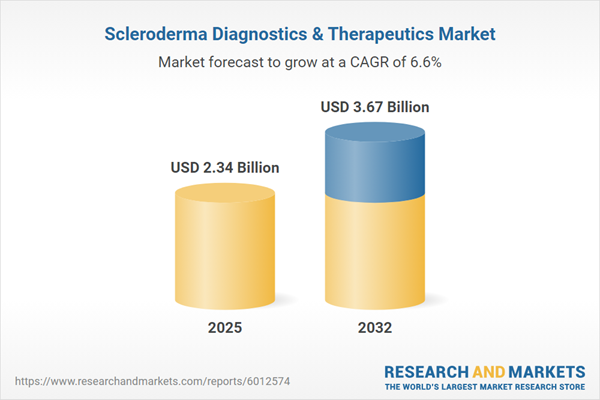Speak directly to the analyst to clarify any post sales queries you may have.
The Scleroderma Diagnostics & Therapeutics Market is transforming as diagnostics and treatment strategies advance, with digital care solutions enhancing operational agility. Today’s senior decision-makers must leverage forward-thinking insights to shape sustainable strategies and maintain competitiveness.
Market Snapshot: Scleroderma Diagnostics & Therapeutics Market
The Scleroderma Diagnostics & Therapeutics Market continues to expand steadily, valued at USD 2.19 billion in 2024 and anticipated to achieve USD 2.34 billion in 2025. This trajectory leads to a projected USD 3.67 billion by 2032, with a compound annual growth rate (CAGR) of 6.64%. Key drivers include widespread adoption of precision medicine, evolving approaches in molecular and imaging diagnostics, and ongoing investment in innovative therapeutic modalities. Market participants adjust operations in response to regulatory developments and sustained funding, prompting refinement of strategies that address the evolving competitive landscape. Leading organizations and emerging players alike are actively pursuing opportunities to capture long-term value in this sector.
Scope & Segmentation: Market Dynamics
- Therapeutic Class: Antifibrotic agents such as nintedanib and pirfenidone broaden available treatment pathways. Expanding use of biologics, immunosuppressants like steroids, methotrexate, and cyclophosphamide, coupled with vasodilators including calcium channel blockers and endothelin receptor antagonists, enhances therapy customization for patient subgroups.
- Diagnosis Type: Autoantibody assays—such as Anti-Scl-70 and anticentromere—together with biomarker analysis, capillaroscopy, high-resolution CT, ultrasound, and advanced molecular diagnostics, support earlier intervention and aid clinical decision-making for diverse presentations.
- Product: Diagnostic instruments (like capillaroscopy tools and imaging systems), autoantibody detection kits, specialty reagents, and integrated software platforms, serve both clinical workflow optimization and scalable research initiatives.
- End Users: Diagnostic laboratories, hospitals, research centers, and specialty clinics integrate these innovations to streamline workflows and elevate patient management efficiency across healthcare environments.
- Disease Form: Recognition of diffuse cutaneous and limited cutaneous scleroderma facilitates precise treatment paradigms and structured care pathways across networks.
- Distribution Channel: Direct sales, distributor networks, and online platforms ensure reliable access, efficient supply, and consistent delivery of advanced diagnostic and therapeutic resources.
- Regions Covered: Diverse commercial and regulatory climates in the Americas, EMEA, and Asia-Pacific introduce regional complexities. Tailored approaches and robust risk assessments help organizations navigate varying market-entry, reimbursement, and compliance scenarios.
- Companies Profiled: Strategic innovation in both diagnostics and therapeutics is led by Bio-Rad Laboratories, Roche, Thermo Fisher Scientific, PerkinElmer, Trinity Biotech, Antibodies Inc., Exagen, Myriad Genetics, Boehringer Ingelheim, Sanofi Genzyme, Bristol-Myers Squibb, Pfizer, Novartis, Bayer, and Galapagos NV.
Key Takeaways: Strategic Insights
- Molecular and advanced imaging diagnostics are supporting earlier disease identification, enabling health systems to refine models for more targeted delivery and optimized patient stratification.
- Personalized and combination therapy options enable care teams to align interventions to specific disease patterns, strengthening outcomes within diverse provider networks.
- Utilization of AI-driven analytics and telemedicine technologies is streamlining operational workflows while supporting higher engagement and improved patient adherence.
- Regulatory process flexibility and increased dependence on real-world clinical data pave the way for accelerated uptake of innovative diagnostics and novel treatments in various regions.
- Investments in domestic manufacturing and procurement partnerships reinforce supply chain resilience, reducing vulnerability to logistical disruptions and supporting organizational stability.
- Infrastructure enhancements and evolving reimbursement policies are expanding patient access to advanced solutions and fostering improvements in global healthcare quality.
Tariff Impact: Navigating Economic Shifts
Forthcoming U.S. tariffs affecting diagnostic devices, imaging equipment, and reagent imports prompt stakeholders to reevaluate sourcing and procurement strategies. Companies are implementing measures such as strengthening domestic manufacturing, establishing procurement alliances, and expanding vendor diversity to manage cost pressures and ensure access to essential technologies during periods of economic change.
Methodology & Data Sources
This analysis is based on a multi-source methodology, blending expert interviews and direct stakeholder feedback. Each finding is cross-validated through clinical studies, regulatory records, and trusted industry databases, providing actionable insights for senior leadership teams navigating the scleroderma market.
Why This Report Matters
- Enables leaders to identify innovation trajectories, optimize resource allocation, and strengthen market positioning within scleroderma diagnostics and therapeutics.
- Delivers comprehensive perspectives on regional developments and competitor activity, equipping teams to adjust strategies in response to ongoing shifts.
- Informs executives on managing regulatory and technological evolution, supporting operational resilience and risk mitigation worldwide.
Conclusion
With these market insights, senior decision-makers can extend operational agility, prepare proactively for market shifts, and reinforce a competitive edge as the landscape for scleroderma diagnostics and therapeutics evolves.
Additional Product Information:
- Purchase of this report includes 1 year online access with quarterly updates.
- This report can be updated on request. Please contact our Customer Experience team using the Ask a Question widget on our website.
Table of Contents
3. Executive Summary
4. Market Overview
7. Cumulative Impact of Artificial Intelligence 2025
Companies Mentioned
The companies profiled in this Scleroderma Diagnostics & Therapeutics market report include:- Bio-Rad Laboratories, Inc
- F. Hoffmann-La Roche Ltd.
- Thermo Fisher Scientific Inc.
- PerkinElmer Inc.
- Trinity Biotech PLC.
- Antibodies Inc.
- Exagen Inc.
- Myriad Genetics, Inc
- Boehringer Ingelheim Pharmaceuticals, Inc.
- Sanofi Genzyme
- The Bristol-Myers Squibb Company
- Pfizer Inc.
- Novartis AG
- Bayer AG
- Galapagos NV
Table Information
| Report Attribute | Details |
|---|---|
| No. of Pages | 196 |
| Published | November 2025 |
| Forecast Period | 2025 - 2032 |
| Estimated Market Value ( USD | $ 2.34 Billion |
| Forecasted Market Value ( USD | $ 3.67 Billion |
| Compound Annual Growth Rate | 6.6% |
| Regions Covered | Global |
| No. of Companies Mentioned | 16 |









